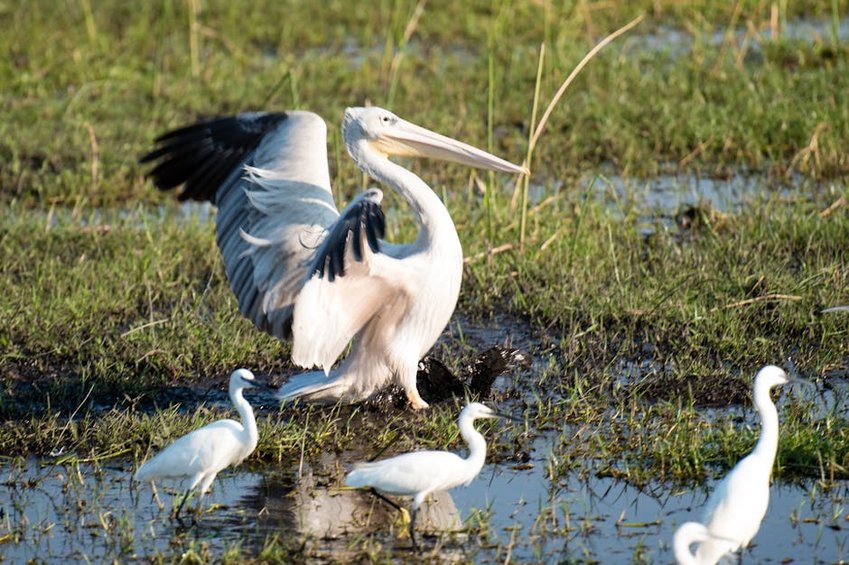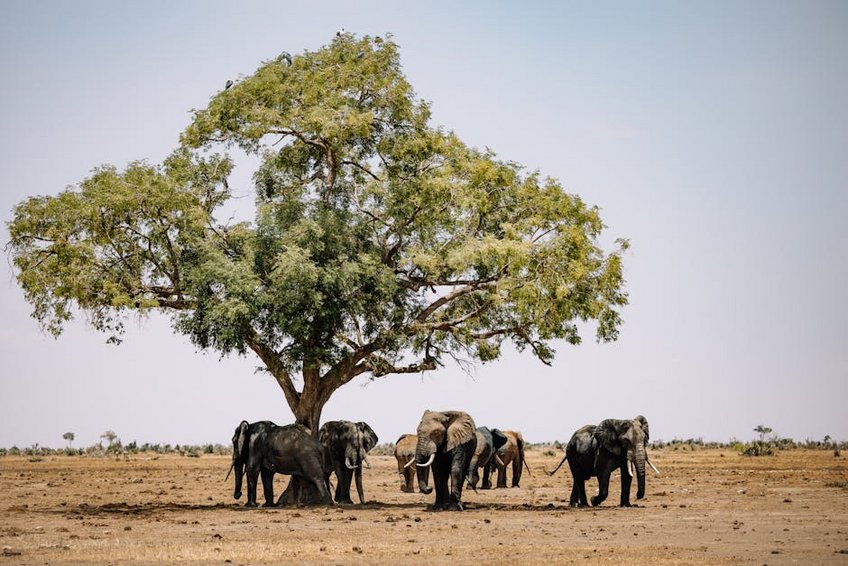Botswana Okavango Delta Safari: Your Ultimate African Adventure Guide
Imagine gliding through crystal-clear waterways in a traditional mokoro canoe while elephants drink peacefully nearby and hippos surface with gentle splashes—this is the magic awaiting you on a Botswana Okavango Delta safari. As one of Africa’s last untouched wilderness areas, this UNESCO World Heritage site offers an unparalleled safari experience that combines breathtaking landscapes with incredible wildlife encounters. You’ll discover why Botswana consistently ranks as a top destination for discerning travelers seeking authentic African adventures. The Okavango Delta’s unique ecosystem, where floodwaters from Angola create a sprawling inland delta, supports diverse habitats that attract everything from majestic lions to colorful bird species. Whether you’re a first-time safari-goer or a seasoned Africa enthusiast, this journey promises moments that will stay with you forever. I’ve explored numerous safari destinations across the continent, and the Botswana Okavango Delta safari stands out for its pristine wilderness, exclusive camps, and commitment to sustainable tourism. In this comprehensive guide, I’ll share everything you need to plan your dream adventure, from seasonal considerations to budget-friendly options, ensuring you make the most of this extraordinary experience.
Botswana Okavango Delta Safari – Essential Information
Understanding the Okavango Delta’s unique geography and Botswana’s conservation approach will greatly enhance your safari experience. Unlike typical river deltas that flow into oceans, the Okavango Delta is an inland system where the Okavango River spreads across the Kalahari Desert, creating a massive oasis that supports incredible biodiversity. This annual flooding cycle, peaking between June and August, transforms the landscape and dictates wildlife movements, making timing crucial for your visit. Botswana has pioneered high-value, low-impact tourism, meaning you’ll encounter fewer vehicles and more intimate wildlife encounters compared to other popular safari destinations. The country’s strict conservation policies have helped protect species like the endangered African wild dog and maintain healthy predator populations. You’ll appreciate how local communities benefit from tourism through employment and community trusts, ensuring your visit contributes positively to regional development. The delta’s varied habitats—from permanent swamps to seasonal floodplains and dry islands—create micro-ecosystems that support different wildlife throughout the year.
What Makes the Okavango Delta Unique
- The delta is the world’s largest inland delta, covering approximately 15,000 square kilometers during peak flood season, creating a unique watery wilderness unlike any other safari destination.
- Botswana’s conservation model focuses on photographic tourism rather than hunting, resulting in wildlife that is generally less fearful of vehicles and better for photography.
- Seasonal flooding reverses traditional dry season patterns—while other parks experience water scarcity, the delta comes alive with water-based activities from June to October.
- Budget options ($200-400 per night): Self-drive camping in Moremi Game Reserve periphery, community-run campsites, or budget safari packages combining camping with selected activities—perfect for adventurous travelers comfortable with basic facilities.
- Mid-range options ($400-800 per night): Comfortable permanent camps with en-suite bathrooms, included activities, and better locations within private concessions offering excellent wildlife viewing without luxury amenities.
- Luxury options ($800-2000+ per night): Exclusive camps in prime locations with premium guiding, private vehicles, gourmet dining, and amenities like pools and spas—ideal for special occasions or travelers seeking utmost comfort.
- Botswana Tourism Organization Official Site
- Lonely Planet Okavango Delta Travel Guide
- National Geographic Okavango Delta Resources
Botswana’s Safari Philosophy and Conservation
Botswana has deliberately chosen a low-volume, high-value tourism strategy that limits visitor numbers through exclusive concessions and higher pricing. This approach means you’ll rarely encounter more than a few vehicles at wildlife sightings, creating a more personal and undisturbed experience. The government works closely with private operators and local communities to manage wildlife corridors and anti-poaching efforts, resulting in some of Africa’s healthiest elephant populations. You’ll notice that camps and lodges emphasize environmental sustainability, with many using solar power, water recycling systems, and employing primarily local staff. This model not only protects the ecosystem but ensures that tourism revenue directly benefits Batswana people through jobs, training programs, and community development projects. The result is a safari experience where you feel genuinely connected to both the wilderness and the people who call it home.
Botswana Okavango Delta Safari – Planning Your Trip
Proper planning transforms a good safari into an extraordinary one, especially for the Okavango Delta where seasonal changes dramatically affect what you’ll experience. I recommend starting your planning at least 6-9 months in advance, particularly if you’re targeting peak season (June-October) or specific luxury camps that book up quickly. Your itinerary should balance water-based activities like mokoro excursions and boat safaris with traditional game drives to experience the delta’s full diversity. Consider combining the Okavango with other Botswana highlights like Chobe National Park or the Makgadikgadi Pans for a comprehensive Botswana experience. You’ll need to decide between mobile safaris that move between locations and fixed camps that offer deeper exploration of specific areas—each has advantages depending on your interests and travel style. Remember that the delta’s remote location means limited connectivity, so embrace this digital detox opportunity and prepare accordingly with downloaded maps and entertainment.
Best Time to Visit the Okavango Delta
The ideal time for your Botswana Okavango Delta safari depends entirely on what you want to experience, as the delta transforms dramatically throughout the year. For peak wildlife viewing and water activities, visit during the dry season from June to October when floodwaters are highest, animals concentrate around permanent water sources, and skies are clear. If you prefer fewer visitors and lower prices, consider the shoulder months of April-May or November, though some areas might be inaccessible due to water levels or rain. The green season (December-March) offers spectacular birdwatching, newborn animals, and dramatic thunderstorms, though afternoon rains can occasionally disrupt activities. I particularly love September-October when receding waters create intense predator-prey interactions around shrinking pools. No matter when you visit, you’ll witness nature’s incredible adaptability in this dynamic ecosystem.
Budget Planning and Costs
Essential Preparation Checklist
Preparing properly ensures you fully enjoy your Botswana Okavango Delta safari without unnecessary stress. First, consult your doctor about malaria prophylaxis since the delta is in a malaria zone, and ensure routine vaccinations are current. Pack neutral-colored clothing (khaki, green, brown) for game drives, plus a warm layer for chilly morning activities and rain protection for summer months. Don’t forget quality binoculars, a camera with extra memory cards, and power banks since electricity might be limited. Arrange comprehensive travel insurance that covers emergency medical evacuation from remote areas. mentally prepare for early starts—wildlife is most active around dawn—and embrace the slower pace of bush life where schedules adapt to animal movements and weather conditions.

Botswana Okavango Delta Safari – Top Attractions and Activities
The Okavango Delta delivers unforgettable experiences that blend adrenaline-pumping wildlife encounters with serene moments of connection to nature. Water-based activities define the delta experience, with mokoro (traditional dugout canoe) trips offering intimate perspectives as guides poling through narrow channels reveal hidden wonders like tiny frogs and water lilies. Motorboat safaris access deeper channels where you might spot swimming elephants or antelope crossing between islands. Traditional game drives on larger islands showcase predator action, especially around Savuti and Khwai regions where lion prides specialize in hunting buffalo. Walking safaris with armed guides provide thrilling ground-level encounters and deeper understanding of tracking and smaller ecosystems. Many visitors are surprised by the excellent birdwatching—over 400 species including iconic African fish eagles and colorful carmine bee-eaters. Night drives reveal a different world of nocturnal creatures like genets, bushbabies, and hunting leopards.
Must-See Highlights
Certain experiences should anchor any Botswana Okavango Delta safari itinerary for maximum impact. The Moremi Game Reserve, often called “the predator capital,” delivers consistent lion, leopard, and wild dog sightings amid beautiful riverine forests and floodplains. Exploring the permanent swamps around Chief’s Island by mokoro provides that classic delta experience of gliding silently past grazing red lechwe and listening to hippo conversations. The Khwai Concession adjacent to Moremi offers fantastic year-round wildlife and cultural interactions with local communities. For something unique, consider a scenic flight over the delta—seeing the vast water networks from above puts the scale and beauty into breathtaking perspective. Don’t miss sundowner moments when you stop for drinks as the African sun sets, often with wildlife silhouetted against spectacular skies—these become among your most cherished memories.
Hidden Gems and Local Favorites
Venture beyond the obvious spots to discover the delta’s secret treasures that few tourists experience. The Jao Flats area during low water (November-December) attracts enormous herds of buffalo with attendant predators, creating dramatic scenes. Community-run activities in the Panhandle region offer cultural exchanges and fishing opportunities that differ from southern delta experiences. The remote Xaxaba area provides incredible bird concentrations and opportunities to see the rare Pel’s fishing owl. During the green season, the Gomoti region comes alive with newborn impala and spectacular wildflowers. Many guides know specific giant baobab trees that serve as natural landmarks and make perfect picnic spots. For photography enthusiasts, asking your guide about “hide” opportunities—blinds near waterholes—can yield incredible close-up shots of unsuspecting animals going about their daily routines.
Seasonal Wildlife Patterns
Understanding how wildlife moves with the waters will help you choose activities and locations matching your interests. During high flood (June-August), animals disperse across newly flooded areas, making water-based activities prime for seeing sitatunga, lechwe, and elephants swimming between islands. As waters recede (September-October), wildlife concentrates around remaining channels and pools, creating predator hotspots perfect for game drives. The summer rains (November-March) trigger migrations as animals move to fresh grazing, while resident species give birth—ideal for seeing vulnerable newborns and hunting opportunities. Birders will find November-April spectacular with migratory species present and breeding plumage displays. Even within seasons, micro-movements occur daily—your guide’s knowledge of local patterns becomes invaluable for positioning you for the best sightings.
Botswana Okavango Delta Safari – Practical Travel Information
Navigating the practicalities of your Botswana Okavango Delta safari ensures smooth travels from arrival to departure. Most international visitors fly into Johannesburg or Nairobi before connecting to Maun, Botswana’s tourism hub, where you’ll typically transfer to smaller aircraft for flights to your specific camp. Visa requirements vary—US and EU passport holders generally receive 90-day visas on arrival, but always verify current regulations before traveling. The Botswana currency is the Pula, though USD are widely accepted at camps for extras and tips; credit cards work at larger establishments but carry cash for remote areas. Communication can be limited—many camps have satellite phones for emergencies but minimal internet; embrace this digital detox opportunity. Health considerations include malaria prophylaxis recommended for the delta region and comprehensive travel insurance mandatory for most safari operators. The tourism infrastructure is well-developed with professional guides, though distances between areas mean significant transfer times that become part of the adventure.
| Accommodation Type | Key Features and Experience | Price Range (USD per night) |
|---|---|---|
| Mobile Tented Camps | Seasonal locations moving with wildlife, authentic bush experience, shared facilities | $300-600 |
| Permanent Tented Camps | Fixed locations with en-suite bathrooms, higher comfort level, included activities | $500-900 |
| Luxury Lodges | Prime locations with pools, spas, premium guiding, private vehicles available | $800-2000+ |


